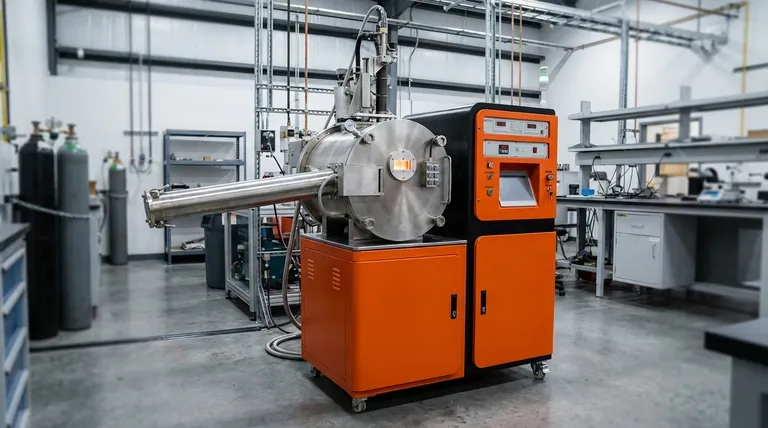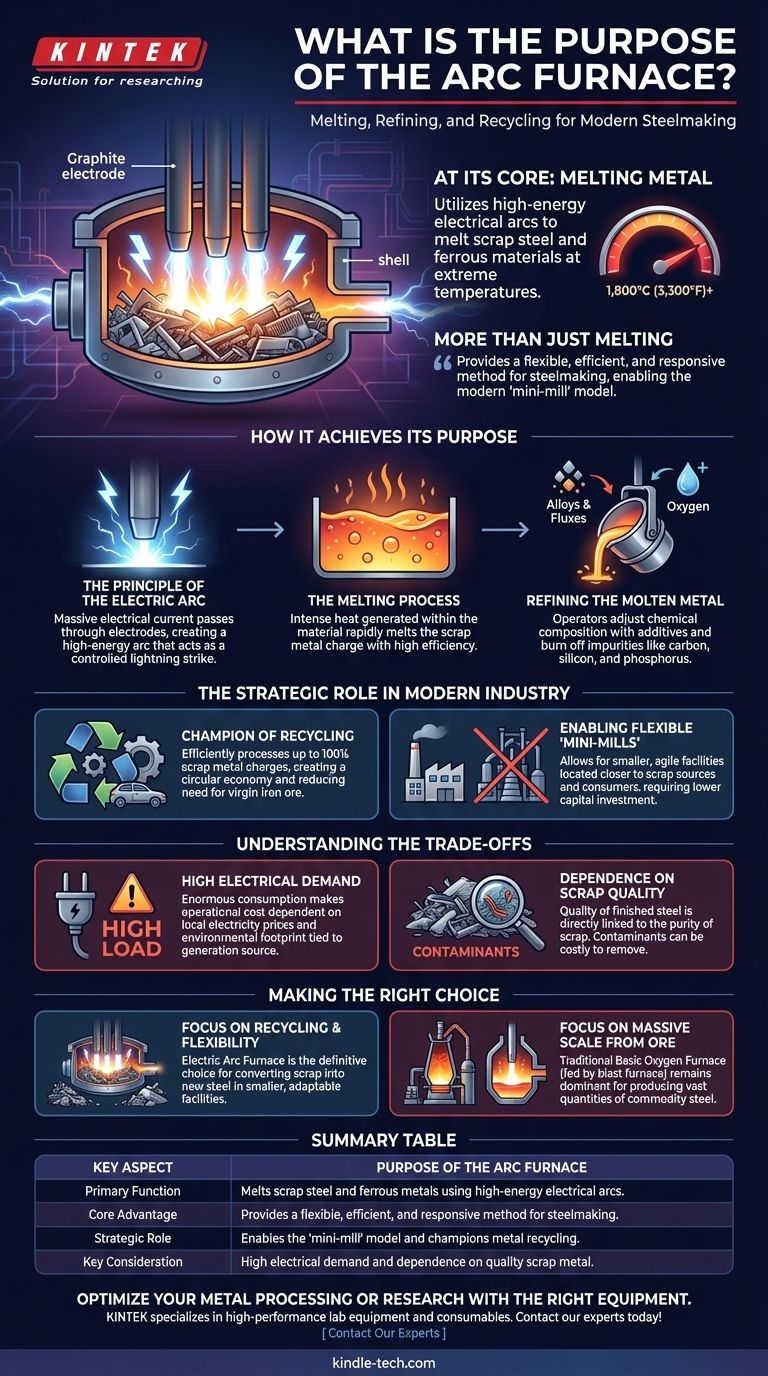At its core, an electric arc furnace (EAF) is a powerful tool for melting metal. It uses high-energy electrical arcs to melt scrap steel and other ferrous materials at extreme temperatures. This function makes it a cornerstone of modern metal recycling and specialized steel production, offering a distinct alternative to traditional ore-based methods.
The true purpose of the arc furnace is not just to melt metal, but to provide a flexible, efficient, and more responsive method for steelmaking. It fundamentally enables the modern "mini-mill" model, which thrives on recycling scrap into high-quality new steel.

How an Arc Furnace Achieves Its Purpose
The operation of an EAF is a process of controlled, immense power. It transforms solid metal into a liquid state ready for casting and forming by focusing intense energy directly onto the material.
The Principle of the Electric Arc
The furnace's primary mechanism involves large graphite electrodes. These are lowered into a sealed chamber, or "shell," filled with the metal to be melted.
A massive electrical current is passed through the electrodes, creating a high-energy arc that leaps from the electrode to the metal. This is functionally a controlled lightning strike.
The Melting Process
The electrical arc generates immense heat, with temperatures inside the furnace exceeding 1,800°C (3,300°F). This is more than sufficient to rapidly melt the scrap metal charge.
This direct application of heat is highly efficient, as the energy is generated within the material itself, minimizing heat loss to the surrounding environment compared to other furnace types.
Refining the Molten Metal
Melting is only the first step. The EAF also serves as a refining vessel.
During the process, operators can introduce alloys and fluxes into the molten bath to adjust the chemical composition. Oxygen may also be injected to burn off impurities like carbon, silicon, and phosphorus, refining the liquid metal into a specific grade of steel.
The Strategic Role in Modern Industry
The EAF is not just a piece of equipment; it represents a strategic shift in how steel is produced. Its purpose is deeply tied to the economics and logistics of the modern metal industry.
Champion of Recycling
The arc furnace is the key enabler of the steel recycling industry. It can efficiently process 100% scrap metal charges, turning old automobiles, structural beams, and appliances back into high-quality steel.
This creates a circular economy for one of the world's most critical materials, reducing the need for virgin iron ore and the associated mining activities.
Enabling Flexible "Mini-Mills"
Unlike massive, traditional integrated steel mills that require blast furnaces and extensive raw material infrastructure, EAFs can be built on a much smaller scale.
These "mini-mills" can be located closer to population centers where scrap is generated and steel is consumed. This agility allows for lower capital investment and a more responsive production schedule.
Understanding the Trade-offs
While highly effective, the purpose and application of the arc furnace are defined by its specific advantages and limitations.
High Electrical Demand
The primary drawback of an EAF is its enormous consumption of electricity. An EAF facility can be one of the largest electrical loads on a regional power grid.
This makes its operational cost highly dependent on local electricity prices. Furthermore, its environmental footprint is tied to how that electricity is generated—whether from fossil fuels or renewable sources.
Dependence on Scrap Quality
The principle of "garbage in, garbage out" applies directly to arc furnaces. The quality of the finished steel is directly linked to the chemical purity of the scrap metal used.
Contaminants in the scrap, such as copper from wiring, can be difficult and costly to remove, potentially limiting the types of steel that can be produced.
Making the Right Choice for Your Goal
The decision to use an electric arc furnace is a strategic one based entirely on the production goal and available resources.
- If your primary focus is recycling and flexible production: The electric arc furnace is the definitive choice, excelling at converting scrap metal into new steel within smaller, adaptable facilities.
- If your primary focus is massive-scale production from raw iron ore: The traditional Basic Oxygen Furnace (fed by a blast furnace) remains the dominant technology for producing vast quantities of commodity steel.
Ultimately, the purpose of the arc furnace is to empower a more sustainable, decentralized, and responsive model of modern metallurgy.
Summary Table:
| Key Aspect | Purpose of the Arc Furnace |
|---|---|
| Primary Function | Melts scrap steel and ferrous metals using high-energy electrical arcs. |
| Core Advantage | Provides a flexible, efficient, and responsive method for steelmaking. |
| Strategic Role | Enables the "mini-mill" model and champions metal recycling. |
| Key Consideration | High electrical demand and dependence on quality scrap metal. |
Optimize your metal processing or research with the right equipment. KINTEK specializes in high-performance lab equipment and consumables, serving the precise needs of laboratories and research facilities. Whether you're exploring thermal applications or require reliable consumables, our solutions are designed to enhance your efficiency and results. Contact our experts today to discuss how we can support your specific goals!
Visual Guide

Related Products
- Vacuum Induction Melting Spinning System Arc Melting Furnace
- 1400℃ Laboratory Quartz Tube Furnace with Alumina Tube Tubular Furnace
- Vertical Laboratory Quartz Tube Furnace Tubular Furnace
- 1700℃ Laboratory Quartz Tube Furnace with Alumina Tube Tubular Furnace
- 1800℃ Muffle Oven Furnace for Laboratory
People Also Ask
- What is magnetron sputtering machine? Precision Thin-Film Deposition for Advanced Materials
- What is RF magnetron sputtering? A Guide to Depositing Insulating Thin Films
- What are the different melting methods? A Guide to Choosing the Right Industrial Furnace
- What is a magnetron sputtering? A Guide to High-Quality Thin-Film Deposition
- What is a sputtering system? Achieve Unmatched Thin Film Deposition for Your Lab



















